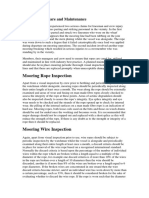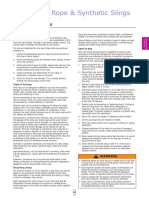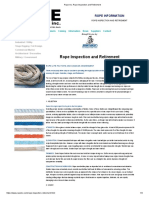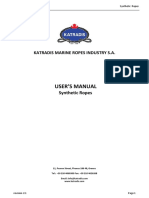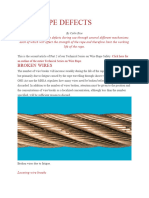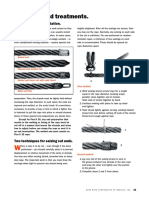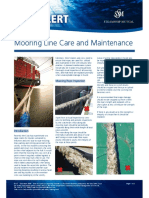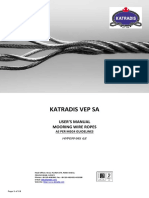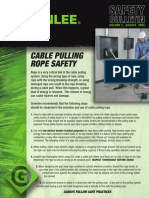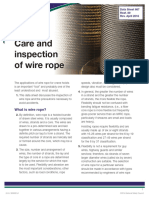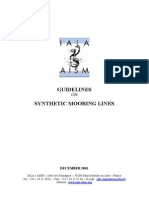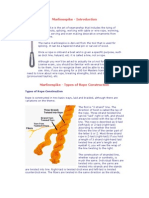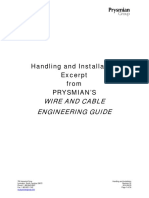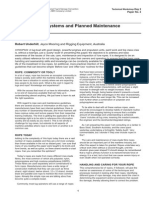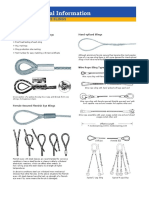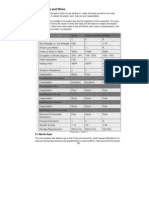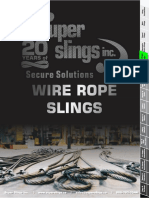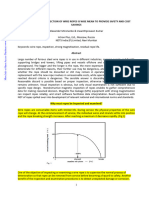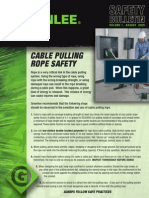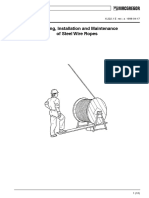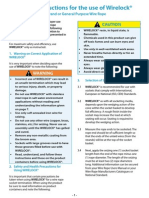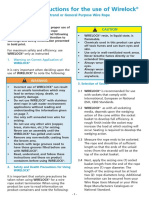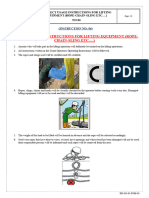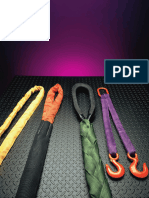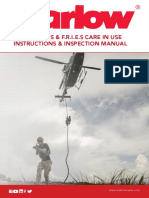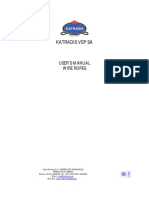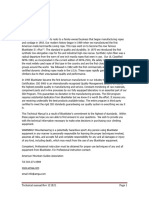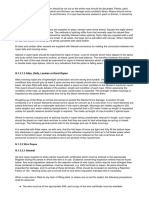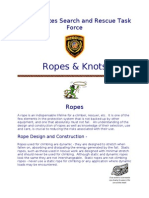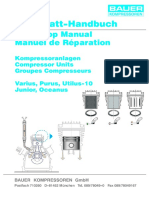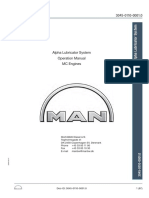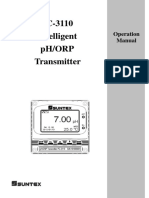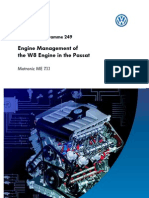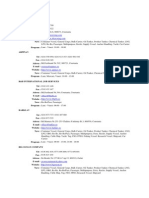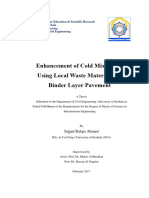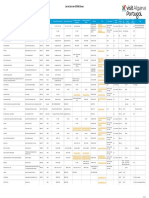Accident Accidents_during_Mooring_Operations_1718314219
Accident Accidents_during_Mooring_Operations_1718314219
Uploaded by
Wee WeeCopyright:
Available Formats
Accident Accidents_during_Mooring_Operations_1718314219
Accident Accidents_during_Mooring_Operations_1718314219
Uploaded by
Wee WeeCopyright
Available Formats
Share this document
Did you find this document useful?
Is this content inappropriate?
Copyright:
Available Formats
Accident Accidents_during_Mooring_Operations_1718314219
Accident Accidents_during_Mooring_Operations_1718314219
Uploaded by
Wee WeeCopyright:
Available Formats
Accidents during Mooring Operations
Loss Prevention Bulletin
The Club’s analysis of significant claims found that
approximately 5% of all severe personal injuries happened
during mooring or towing operations.
Dean Crossley
(Loss Prevention Manager, West P&I)
Although a substantial proportion of these claims resulted from slips, trips and falls, almost half were caused by parting
lines or involved crewmembers’ failure to abide by safe working practices whilst handling lines. The invariable aftermath of
these incidents resulted in lifechanging injuries as well as emotional trauma being suffered. In response to such accidents,
this bulletin has been written to reemphasise correct procedures and promote good practice.
1 of 7 © 2023 West of England
General
Routine precautions should include regular checks of the deck areas used for mooring operations. Unless already fitted
with treads, mooring decks’ surfaces should be treated with antislip paint and must be kept clean and free of clutter.
Mooring winches and deck fixtures and fittings should be inspected, maintained, and greased according to the vessel’s
Planned Maintenance System (PMS) requirements. In particular leaking joints in hydraulic lines should be rectified,
possibly considering the construction of save-alls to protect the decks from further leakage.
Fairleads and rollers should be regularly lubricated,
checked for free movement, examined for wear, and bitts
examined for distortion and fractures. Leads that have
previously been used for wires should be inspected for
metal damage before being used with fibre ropes.
Winches must operate and stop smoothly and be isolated
after use.
Directions of movement should be clearly marked. Winch
brakes maintained in good order, with all linkages working
satisfactorily and adequate brake lining thickness per the
manufacturer’s instructions. Winch drums are designed
such that they are most effective at holding a rope under
tension when the line is pulling against the fixed end of the
brake band arrangement. Therefore, it must be ensured
that lines are wound onto drums according to the
manufacturers’ recommendations to ensure the brake
does not fail prematurely.
On winch drums fitted with disc brakes, ropes can be
wound onto the drum in either direction. Regardless of
type, winch brakes should be set to render at
approximately 60% of the Minimum Breaking Load (MBL)
of the rope on the drum. Clutches should operate
smoothly, and clutch control lever securing pins fitted
ready for use. Drum ends should be smooth, clean, and
free from grooving damage, rust, paint and oil. Before
mooring operations commencing, all winches, ropes,
fixtures, and fittings should be visually examined and
machinery tested; any defective equipment should be
taken out of service and repaired or replaced before use.
Care of Ropes
Unless proper care is exercised to preserve the condition of a line, its tendency to break under tension may increase
significantly and reinforces the necessity for a comprehensive Line Management Plan (LMP) to be implemented. When
considering the rope care protocols to be carried out onboard, integrating the manufacturer’s instructions and
recommendations into the vessel’s PMS is a vital component of the process.
Fibre Ropes Wire Ropes
2 of 7 © 2023 West of England
Almost all fibre ropes in use at sea today are With the correct lubricant grade, lubrication should be
manufactured from synthetic materials. Mooring lines are carried out regularly to minimise internal and external
often made of polypropylene, polyester or high modulus corrosion, and cores must not be allowed to dry out. A
polyethylene (HMPE). Different synthetic materials have kinked wire will reduce strength; therefore, care must be
unique properties; HMPE, for example, is resistant to most taken to avoid bending it excessively. Similarly, crossing
chemicals but will melt at a lower temperature than wires on the drum end may cause the line to become
polypropylene; therefore, the synthetic fibre ropes’ unique crushed or flattened. The presence of snags, kinks, bird
properties in use onboard should be known and caging, crushed or flattened strands, and corrosion
appropriate precautions are taken. reduces the wire’s strength. Wires, including splices,
should be periodically examined along their entire length
Ultra-violet rays may result in actinic degradation, and and any damage evaluated in line with the company’s wire
coils of synthetic ropes should always be stored away discard criteria, which should be detailed in the vessel’s
from direct sunlight when not in use and covered when in Safety Management System (SMS), to determine whether
port. The ropes should be stowed well away from paint, replacement is necessary. If a wire’s strength is in any
thinners and chemicals as these substances’ vapours may doubt, it should be taken out of service and replaced.
also cause damage. Storage areas should be well When handling wire ropes, suitable gloves should always
ventilated and fitted with wooden gratings or pallets to be worn to protect the hands from snags.
assist drainage and improve air circulation. Ropes should
never be stowed against hot bulkheads.
A visual inspection of synthetic ropes should be made at Parting Ropes
frequent intervals, including a thorough examination of the
inner strands and the condition of the splices. “Powdering” When berthing, the most critical period is often after the
between strands is usually an indication of excessive wear first line has been sent ashore. The strain on a single line
and weakness. Excessive surging from warping drums or may be considerable, significantly increasing the risk of its
bitts should be avoided as friction may cause the fibres to parting. Although synthetic ropes have great elasticity and
fuse, resulting in a reduction in strength. The fitting of eye an excellent capacity to absorb sudden shock, breaking
splice protectors around rope eyes may provide additional when under stress may produce a potentially dangerous
protection against wear. When the working end of a rope, snapback. It is difficult to predict when a synthetic rope
be it on a winch drum or a loose coil, becomes worn or under strain approaches its breaking point as audible
damaged, it should as a temporary measure be either be indications are often absent. Personnel on the mooring
cropped and re-spliced or the rope “end for ended”. deck should always stand in positions of safety in such
circumstances, clear of the snap-back zone area.
Wire ropes have less elasticity but may give a prior
warning if about to part. Sharp cracks may be heard, and
individual strands may begin to unravel before the
breaking point is reached. Although a parting wire may not
travel as far as a synthetic rope, snap-back effects can be
equally harmful. Even when fitted with a synthetic fibre
rope tail, wire rope’s limited ability to absorb shock makes
it desirable that only fibre ropes are used as first lines to
heave a vessel alongside. Whenever a line is observed to
be coming under excessive strain, all possible measures
shall be taken to reduce the line’s tension so far as is safe
and practicable.
3 of 7 © 2023 West of England
Stoppers
Stoppers should always be of the same type as the fibre rope to be held, of sufficient length and adequate strength;
ideally, 50% of the MBL of the line being held.
Synthetic ropes demand flexible synthetic stoppers made of low-stretch material and with a high melting point. Polyester
and polyamide stoppers are both acceptable; however, it is advised that polyamide stoppers are not used with polyamide
ropes due to its low friction of coefficient. The stoppers should preferably be rigged with both ends free so that they
crossed over and under, “West Country” method can be used.
Chain stoppers should be used with wire ropes, first fastening the chain in a well-spaced “cow hitch” and turning the tail
several times against the lay of the wire. It must be remembered that stoppers serve only to hold the line momentarily while
it is secured, and sudden shocks or increased load may cause the stopper to part. Once a rope has been laid up on the
bitts, Loss Prevention Bulletin the stopper must be removed from the rope. When a line has been tensioned on a drum
end, it must be stoppered and transferred to mooring bitts; it is bad practice to leave lines on drum ends that are not in the
process of being tensioned or slacked
4 of 7 © 2023 West of England
Mooring Operations
The mooring officer should alert shore
It is essential that sufficient personnel Additionally, there must be a clear personnel before a heaving line is
are detailed to attend the mooring communication line between the thrown and warn the mooring party
operation and that the activities to be mooring officer and the linesman, and when it is about to be thrown back to
undertaken are adequately explained parities must always maintain visual the ship. Being hit by the end of a
and supervised by a deck officer. contact during the operations. There heaving line can cause serious injury,
Personnel not involved in the mooring should be one linesman who is clearly and the “monkey’s fist” should only be
operation should be kept well clear of identifiable as the contact point to made of rope and never be formed
the mooring decks. In the event of an which visible/hand signals are around a heavy weight.
unusual or non-standard mooring communicated. The mooring officer
operation, it is recommended that a should not get involved in the physical Split drum winches are designed so
new risk assessment be completed mooring activities but should maintain that the line should leave the drum’s
before the operation commences as an overview of the operation. Keeping tension side from the first wrap of rope
they will potential have associated a sharp lookout for potential hazards to ensure maximum holding capacity.
hazards not covered within the risk should be considered an integral part Care must be taken when
assessment done for a standard of the mooring officer’s duty. crewmembers are transferring the rope
mooring operation. from the drum’s storage side to the
The officer should also ensure that the tension side; the rope should be pulled
The officer should take charge of the mooring party wears correct personal through the gap in the drum divider
communication link between the protective equipment in line with the rather than pushed, as it may spring
mooring deck and the bridge. All requirements of the vessel’s SMS, back and strike the crewmember.
communications should identify the which will include, as a minimum,
vessel to ensure that no safety helmets (with chinstraps
misunderstandings occur when other secured), appropriate footwear, and
vessels communicate on the same high visibility clothing which will not
radio frequency. Accurate reporting to become entangled during mooring
the bridge is essential, with instructions operations. Safety goggles should be
from the bridge acknowledged, available if an anchor needs to be
repeated and then confirmed once used, and gloves should be used
actioned. The bridge must also be whenever wire ropes are handled due
advised when all ropes, be they to the danger of injury from broken
moorings or tugs lines, are clear of the wires. Provided permission has been
water and main engines and thrusters obtained from the bridge, mooring
can be used. decks should be illuminated at night.
5 of 7 © 2023 West of England
Self-tensioning winches are fitted on some vessels; however, it is recommended that these are not used in self-tensioning
mode when a vessel is connected to a shore manifold or has limited room ahead/or astern of the vessel. There have been
many instances of vessels, when using self-tensioning winches, creeping along a berth due to the prevailing
environmental conditions.
T he responsible officer should also make sure that the basic principles of safe mooring are closely followed
by those working under their direction by ensuring that, as a minimum, the following points are abided by
whilst they are conducting mooring and towage operations:
Never stand within the bight of a line. Don’t surge lines unnecessarily; always endeavour
to winch back.
Never stand in the bight formed between the winch
drum or the drum end and the fairlead. Avoid crossing wires and synthetic fibre ropes or
leading both rope types through the same fairlead.
Always stand in a position of safety, clear of a line’s
snap-back zone area when lines are under tension. Don’t stand too close to the drum end when
Lines will generally snap-back in a direction based heaving or slacking.
upon the direction in which it was leading. When
led around pedestals or bitts, the line will snap-back Ensure that a second person helps each drum-end
around these in a much larger arc. rope handler pay out the line or pick up the slack.
Ensure only experienced crewmembers operate With synthetic lines, don’t apply too many turns to
winch controls. the drum end. Three or four turns are generally
sufficient; however, whelped drums may require
Never leave rotating winches unattended or with more turns.
winch control levers tied off.
All leads within the mooring line arrangements must
Ensure winch operators can see the officer in be of matching dimension, MBL and material.
charge. Where synthetic fibre and wire ropes are available,
the two types should not be mixed in the same
Always try and remain in full control of a line. service. For example, breast lines should not be a
mixture of wire and fibre ropes; instead, they should
be either wires or fibre ropes.
Never attempt to stop an unchecked line by
grabbing hold or stepping on it.
Ensure that during the running of the mooring lines
that each service, i.e. breast, spring, head and
When lines are being run using a line boat, the
stern lines, are done as stipulated in the Towing
lines are to be lowered under control to the boat
and Mooring Arrangements Plan and symmetry
and are not to be let go such that they fall
about the vessel’s longitudinal centre line is
uncontrollably into the boat/water.
maintained as much as possible.
Avoid large changes in the direction of a line by
leading ropes and wires around sharp bends.
6 of 7 © 2023 West of England
When making fast to a tug, in most cases, a tug’s line will The eye of a tug’s towing line should be placed over a
be used, however; if a ship’s line is required to make the mooring bitts post clear of rope or wire, and ship’s lines
tug fast, then care should be taken to select the best laid up on the bitts. Bitts should be prominently marked
ship’s line available, ensuring the line is in good condition, with their safe working load (SWL), and the SWL of bitts
has sound splices and does not have short splices within used for towing must exceed the expected dynamic
its length. The ship’s line selected should be of sufficient loadings in the tow line.
strength to withstand any dynamic loading imparted in it
during the towing operation. It is recommended that the Tugs should only be cast-off after receiving instructions
MBL of the ship’s line’s line is at least twice the bollard pull from the bridge and never on the tug crew’s orders.
of the tug. When connecting or letting go towing lines,
either provided by the tug or vessel, these must always be
kept under control, using messengers to heave or slack
the line as necessary. Associated Loss Prevention Bulletins on the topic of
mooring operations which can be seen in the listed
Following any tow line connection, all mooring personnel publications below:
should stand well clear of the operational area as tension
in the towing line often increases rapidly and with little or Snap-Back Zone.
no warning. When needing to work within the operating Monkeys Fists on Heaving Lines - Use of
area or to attend to the tow line, always keep clear of Inappropriate Weighting Material
bights of rope and the towing line’s snap-back zone area.
Members requiring any further guidance are advised to contact the Loss Prevention
department.
Dean Crossley Dean is the Loss Prevention Manager at West P&I's
Loss Prevention Manager London Office. He is a Master Mariner with seagoing
T +44 20 7716 6059 experience on a variety of dry cargo vessel types. Before
E Dean.Crossley@westpandi.com joining the Club in 2016, upon transferring to shore-based
employment, for over 13 years, Dean has worked at an IG
P&I Club in London as a Claims Manager and as a Marine
& Warranty Surveyor at leading marine consultancies
7 of 7 © 2023 West of England
You might also like
- IMPA 6th EdDocument1,646 pagesIMPA 6th EdCristel_DC100% (1)
- Wire Rope LubricationDocument16 pagesWire Rope LubricationAnonymous alQXB11EgQNo ratings yet
- Cash Flow Statement ProjectDocument73 pagesCash Flow Statement Projectmsl 78660% (10)
- Manual For EOT CranesDocument39 pagesManual For EOT CranesManish Jha67% (12)
- important points on wires and ropes - копияDocument2 pagesimportant points on wires and ropes - копияВлад РайлиNo ratings yet
- Mooring Ropes 22-03 Document1Document2 pagesMooring Ropes 22-03 Document1Cesar RodriguezNo ratings yet
- Care in Use Wire Rope SlingsDocument1 pageCare in Use Wire Rope SlingsEhsan Bahrami Gol SorkhdanNo ratings yet
- Rope Inc. Rope Inspection and RetirementDocument4 pagesRope Inc. Rope Inspection and RetirementMr-SmithNo ratings yet
- Manual Synthetic Ropes 2.1 enDocument11 pagesManual Synthetic Ropes 2.1 enengdpaliNo ratings yet
- Wire Rope DefectsDocument5 pagesWire Rope DefectsAnonymous ntE0hG2TP100% (1)
- Wire Rope End Treatments.: Preparation For InstallationDocument10 pagesWire Rope End Treatments.: Preparation For Installationegy pureNo ratings yet
- PT Bhaita Wire Rope Inspection ProcedureDocument4 pagesPT Bhaita Wire Rope Inspection ProcedureSugianto TanNo ratings yet
- Handling Ropes and WiresDocument22 pagesHandling Ropes and WiresSeaman Navigator100% (1)
- Care Maint. StrengthDocument8 pagesCare Maint. StrengthMitanshu ChadhaNo ratings yet
- Mooring Line Care MaintenanceDocument2 pagesMooring Line Care MaintenanceMehmet Ali100% (1)
- User S Manual Wire RopesDocument13 pagesUser S Manual Wire RopesRajesh NairNo ratings yet
- Unit 3. BS SWL Chain Register Incl Wire Rope exam-SENT ONDocument11 pagesUnit 3. BS SWL Chain Register Incl Wire Rope exam-SENT ONDankNo ratings yet
- Greenlee cable-pulling-safetyDocument1 pageGreenlee cable-pulling-safetyloganjtomkoNo ratings yet
- Data WireRope CareDocument5 pagesData WireRope CareHishamNo ratings yet
- Proper Wire Rope UseDocument10 pagesProper Wire Rope Usekartoon_38No ratings yet
- Guidel 26Document25 pagesGuidel 26Ashley PerrettNo ratings yet
- Marlinespike - Introduction: Types of Rope ConstructionDocument23 pagesMarlinespike - Introduction: Types of Rope Constructiondavidantis100% (1)
- Wire RopeDocument4 pagesWire RopedobricovekNo ratings yet
- Handling Installation Rev 22 PDFDocument24 pagesHandling Installation Rev 22 PDFtwo travellerNo ratings yet
- Mooring & Wire RopesDocument14 pagesMooring & Wire RopesAlex100% (2)
- Tug Tow Rope Systems and Planned Maintenance Procedures: Robert Underhill, Jeyco Mooring and Rigging Equipment, AustraliaDocument6 pagesTug Tow Rope Systems and Planned Maintenance Procedures: Robert Underhill, Jeyco Mooring and Rigging Equipment, AustraliaDeanna BarrettNo ratings yet
- General Information: Wire Rope SlingsDocument7 pagesGeneral Information: Wire Rope Slingsegy pureNo ratings yet
- Fiber Rope and Wire RopeDocument20 pagesFiber Rope and Wire RopeGabrielNo ratings yet
- Tow LinesDocument11 pagesTow Linesbill baileyNo ratings yet
- Guidelines For Fiber Optic Cable InstallationDocument14 pagesGuidelines For Fiber Optic Cable InstallationBrielle ManuelNo ratings yet
- Ropes and WiresDocument4 pagesRopes and WiresbernardinodinoNo ratings yet
- Super Slings Rigging Catalog 2020 - 1D Slings Wire Rope 1001 - WebDocument30 pagesSuper Slings Rigging Catalog 2020 - 1D Slings Wire Rope 1001 - WebDouglasFariaNo ratings yet
- Hawser Operating ManualDocument14 pagesHawser Operating ManualFaisal AwanNo ratings yet
- Non-Destructive Inspection of Wire Ropes Is Wise Mean To Provide Safety and Cost SavingsDocument9 pagesNon-Destructive Inspection of Wire Ropes Is Wise Mean To Provide Safety and Cost SavingsThiago Lins CostaNo ratings yet
- Cable Pulling SafetyDocument1 pageCable Pulling SafetyCondro DimukoNo ratings yet
- User's Manual - Synthetic Μooring RopesDocument32 pagesUser's Manual - Synthetic Μooring RopesNikos StratisNo ratings yet
- Wire Rope Users Manual-2Document13 pagesWire Rope Users Manual-2Kathrin KatsNo ratings yet
- Handling, Installation and Maintenance of Steel Wire Ropes: Service 6.222.1 E Rev.: A 1998-04-17Document25 pagesHandling, Installation and Maintenance of Steel Wire Ropes: Service 6.222.1 E Rev.: A 1998-04-17Никита ВеликоцкийNo ratings yet
- Tricks For Cable Accessories InstallationDocument30 pagesTricks For Cable Accessories InstallationcxfuentesNo ratings yet
- TT - Splicing Tips 2023Document1 pageTT - Splicing Tips 2023Zhou YangNo ratings yet
- Instructions For The Use of WirelockDocument6 pagesInstructions For The Use of WirelockLeo MottaNo ratings yet
- PRC-MJP-Hoist Wirelock ProcedureDocument6 pagesPRC-MJP-Hoist Wirelock ProcedureCarlos Bruno MatosNo ratings yet
- Correct Usage Instructions For Lifting EquipmentDocument6 pagesCorrect Usage Instructions For Lifting Equipmentmiraç burak navruzNo ratings yet
- LiftAll - EslingasDocument19 pagesLiftAll - EslingasJoaquín IgoaNo ratings yet
- Fast Rope & Fries Manual June 2019 - ReducedDocument8 pagesFast Rope & Fries Manual June 2019 - ReducedCiyi LinNo ratings yet
- Katradis Vep Sa: User'S Manual Wire RopesDocument17 pagesKatradis Vep Sa: User'S Manual Wire RopesseawizeNo ratings yet
- Effective Mooring2222Document37 pagesEffective Mooring2222Red SkiNo ratings yet
- Technical Manual Rev 121021Document20 pagesTechnical Manual Rev 121021José Alberto Garcia CordovaNo ratings yet
- Wire Rope CriteriaDocument7 pagesWire Rope CriteriaAnkit Vyas100% (1)
- Rope and WiresDocument22 pagesRope and WiresMiki CsereNo ratings yet
- J940305 PDFDocument4 pagesJ940305 PDFratheeshNo ratings yet
- User Manual Powertex Slings -GB-_2Document6 pagesUser Manual Powertex Slings -GB-_2Mugisha JumaNo ratings yet
- Inspection and MaintenanceDocument1 pageInspection and Maintenancejieunibanez507No ratings yet
- Wire RopeDocument9 pagesWire RopeMitanshu ChadhaNo ratings yet
- Ropes and KnotsDocument17 pagesRopes and KnotsraxXEBEDENo ratings yet
- Crane Wire and RopeDocument6 pagesCrane Wire and RopeThusitha DalpathaduNo ratings yet
- Chain InspectionDocument4 pagesChain Inspectionadhi nrNo ratings yet
- The Knot Book - Knots, Bends and Hitches - A Guide for Sailors, Adventurers and HobbyistsFrom EverandThe Knot Book - Knots, Bends and Hitches - A Guide for Sailors, Adventurers and HobbyistsNo ratings yet
- Net Making Made Simple - A Guide to Making Nets for Sport and HomeFrom EverandNet Making Made Simple - A Guide to Making Nets for Sport and HomeNo ratings yet
- Workshop ManualDocument59 pagesWorkshop ManualCristel_DCNo ratings yet
- Alpha Lubricator System - Operation Manual, 2009 3045-0110-0001Document216 pagesAlpha Lubricator System - Operation Manual, 2009 3045-0110-0001Cristel_DCNo ratings yet
- Maintenance Schedule Bauer CompressorsDocument1 pageMaintenance Schedule Bauer CompressorsCristel_DC100% (4)
- EGCS PH Meter - Pc-3110 ManualDocument50 pagesEGCS PH Meter - Pc-3110 ManualCristel_DCNo ratings yet
- Tps 472Document1 pageTps 472Cristel_DCNo ratings yet
- SDS WPDocument80 pagesSDS WPCristel_DCNo ratings yet
- Passat B6Document31 pagesPassat B6Cristel_DC100% (1)
- Passat V8 EngineDocument52 pagesPassat V8 EngineacsservicesNo ratings yet
- Lista AgDocument18 pagesLista AgCristel_DCNo ratings yet
- Center For Research and Development: Cebu Normal UniversityDocument1 pageCenter For Research and Development: Cebu Normal UniversityM. NarnsNo ratings yet
- Control Valve Specification Sheet: Fisher 2 Inches, Fisher 2 Inches, None,, Globe NPS 1/2 CL150 Fisher/24000SBDocument2 pagesControl Valve Specification Sheet: Fisher 2 Inches, Fisher 2 Inches, None,, Globe NPS 1/2 CL150 Fisher/24000SBJavier LopezNo ratings yet
- Exercise - I: Objective Problems (Jee Main)Document21 pagesExercise - I: Objective Problems (Jee Main)PranivoidNo ratings yet
- Lesson 2 Cultural Variations and Cultural Differences Socioeconomic ClassDocument32 pagesLesson 2 Cultural Variations and Cultural Differences Socioeconomic ClassKath Tan Alcantara100% (1)
- What Are The Importance and Benefits of Livestock Farming?Document4 pagesWhat Are The Importance and Benefits of Livestock Farming?Joanne JimenezNo ratings yet
- MATERIALDocument1 pageMATERIALSunil KoolwalNo ratings yet
- Sandeep Kumar: Academic AchievementsDocument1 pageSandeep Kumar: Academic AchievementsSandeep KumarNo ratings yet
- PRS 7367FeederProtectionandControlUnitTechnicalManualV4.00 1 1Document118 pagesPRS 7367FeederProtectionandControlUnitTechnicalManualV4.00 1 1Mearuf MiftahNo ratings yet
- SDFKJ - Google SearchDocument2 pagesSDFKJ - Google SearchAryaman DhootNo ratings yet
- 94 Prof Moeller Summary enDocument18 pages94 Prof Moeller Summary enaptureincNo ratings yet
- DIY Coaster-HeartytDocument10 pagesDIY Coaster-HeartytLiz De CerezaNo ratings yet
- Ifma Fmpv3-0 F-B Ch2Document87 pagesIfma Fmpv3-0 F-B Ch2Mohamed IbrahimNo ratings yet
- Chapter One Fundamentals of Assurance Services I. The Concept of AssuranceDocument11 pagesChapter One Fundamentals of Assurance Services I. The Concept of AssuranceJeremy Lorenzo Teodoro VirataNo ratings yet
- 'On' For Monitored Start (Acknowledge EMERGENCY OFF Cat. 0, Emergency Stop Cat. 1) Ext. Supply (UPS)Document7 pages'On' For Monitored Start (Acknowledge EMERGENCY OFF Cat. 0, Emergency Stop Cat. 1) Ext. Supply (UPS)hamzehNo ratings yet
- RP Enhancement of Cold Mix Asphalt Using Local Waste Materials For Binder Layer PavementDocument159 pagesRP Enhancement of Cold Mix Asphalt Using Local Waste Materials For Binder Layer Pavementwaqed.salmanNo ratings yet
- Alvin Garcia Vs MojicaDocument11 pagesAlvin Garcia Vs MojicaKay AvilesNo ratings yet
- Electrolux Induction - Single Zone - 603522 - English UKDocument2 pagesElectrolux Induction - Single Zone - 603522 - English UKChee Wen ZhiNo ratings yet
- Architecture Dying in The PhilippinesDocument3 pagesArchitecture Dying in The PhilippinesVicheeckoOrtegaNo ratings yet
- Oil DocumentationDocument54 pagesOil DocumentationGustavo AgudeloNo ratings yet
- Samonte Vs GatdulaDocument1 pageSamonte Vs GatdulaKim David100% (1)
- Applications of Different Types of Steam Traps - TLV - A Steam Specialist Company (United Arab Emirates) PDFDocument5 pagesApplications of Different Types of Steam Traps - TLV - A Steam Specialist Company (United Arab Emirates) PDFDũng LêNo ratings yet
- Case Studies - solved - ch.9 - Financial ManagementDocument23 pagesCase Studies - solved - ch.9 - Financial Managementujjwalawasthi9cNo ratings yet
- Genie S 60 S 65 S 60hc and Trax From SN 21001 Parts ManualsDocument20 pagesGenie S 60 S 65 S 60hc and Trax From SN 21001 Parts ManualsLeigh100% (55)
- Adanga PP Daily Production Report 7th March 2021Document10 pagesAdanga PP Daily Production Report 7th March 2021emmanuel francizNo ratings yet
- Accountancy Finance Keywords PDFDocument2 pagesAccountancy Finance Keywords PDFNumair AshrafNo ratings yet
- School New Id 2Document9 pagesSchool New Id 2abc TambagoNo ratings yet
- Checkout GHL IntegrationDocument2 pagesCheckout GHL Integrationvijaysharma771890No ratings yet
- Algarve COVID Testing INFO - WIP - 16 - 06 - 21 PDFDocument3 pagesAlgarve COVID Testing INFO - WIP - 16 - 06 - 21 PDFjoeNo ratings yet





